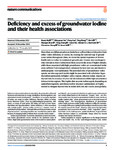Deficiency and excess of groundwater iodine and their health associations
| dc.contributor.author | Ma, R | |
| dc.contributor.author | Yan, M | |
| dc.contributor.author | Han, P | |
| dc.contributor.author | Wang, T | |
| dc.contributor.author | Li, B | |
| dc.contributor.author | Zhou, S | |
| dc.contributor.author | Zheng, T | |
| dc.contributor.author | Hu, Y | |
| dc.contributor.author | Borthwick, Alistair | |
| dc.contributor.author | Zheng, C | |
| dc.contributor.author | Ni, J | |
| dc.date.accessioned | 2023-01-30T15:16:08Z | |
| dc.date.issued | 2022-11-29 | |
| dc.identifier.issn | 2041-1723 | |
| dc.identifier.issn | 2041-1723 | |
| dc.identifier.other | 7354 | |
| dc.identifier.uri | http://hdl.handle.net/10026.1/20217 | |
| dc.description.abstract |
<jats:title>Abstract</jats:title><jats:p>More than two billion people worldwide have suffered thyroid disorders from either iodine deficiency or excess. By creating the national map of groundwater iodine throughout China, we reveal the spatial responses of diverse health risks to iodine in continental groundwater. Greater non-carcinogenic risks relevant to lower iodine more likely occur in the areas of higher altitude, while those associated with high groundwater iodine are concentrated in the areas suffered from transgressions enhanced by land over-use and intensive anthropogenic overexploitation. The potential roles of groundwater iodine species are also explored: iodide might be associated with subclinical hypothyroidism particularly in higher iodine regions, whereas iodate impacts on thyroid risks in presence of universal salt iodization exhibit high uncertainties in lower iodine regions. This implies that accurate iodine supply depending on spatial heterogeneity and dietary iodine structure optimization are highly needed to mitigate thyroid risks in iodine-deficient and -excess areas globally.</jats:p> | |
| dc.format.extent | 7354- | |
| dc.format.medium | Electronic | |
| dc.language | en | |
| dc.language.iso | eng | |
| dc.publisher | Springer Science and Business Media LLC | |
| dc.subject | Humans | |
| dc.subject | Iodides | |
| dc.subject | Iodine | |
| dc.subject | Groundwater | |
| dc.subject | Thyroid Gland | |
| dc.subject | Sodium Chloride, Dietary | |
| dc.title | Deficiency and excess of groundwater iodine and their health associations | |
| dc.type | journal-article | |
| dc.type | Journal Article | |
| dc.type | Research Support, Non-U.S. Gov't | |
| plymouth.author-url | https://www.ncbi.nlm.nih.gov/pubmed/36446773 | |
| plymouth.issue | 1 | |
| plymouth.volume | 13 | |
| plymouth.publication-status | Published online | |
| plymouth.journal | Nature Communications | |
| dc.identifier.doi | 10.1038/s41467-022-35042-6 | |
| plymouth.organisational-group | /Plymouth | |
| plymouth.organisational-group | /Plymouth/Faculty of Science and Engineering | |
| plymouth.organisational-group | /Plymouth/Faculty of Science and Engineering/School of Engineering, Computing and Mathematics | |
| plymouth.organisational-group | /Plymouth/Users by role | |
| plymouth.organisational-group | /Plymouth/Users by role/Academics | |
| dc.publisher.place | England | |
| dcterms.dateAccepted | 2022-11-16 | |
| dc.rights.embargodate | 2023-1-31 | |
| dc.identifier.eissn | 2041-1723 | |
| dc.rights.embargoperiod | Not known | |
| rioxxterms.versionofrecord | 10.1038/s41467-022-35042-6 | |
| rioxxterms.licenseref.uri | http://www.rioxx.net/licenses/all-rights-reserved | |
| rioxxterms.licenseref.startdate | 2022-11-29 | |
| rioxxterms.type | Journal Article/Review |


